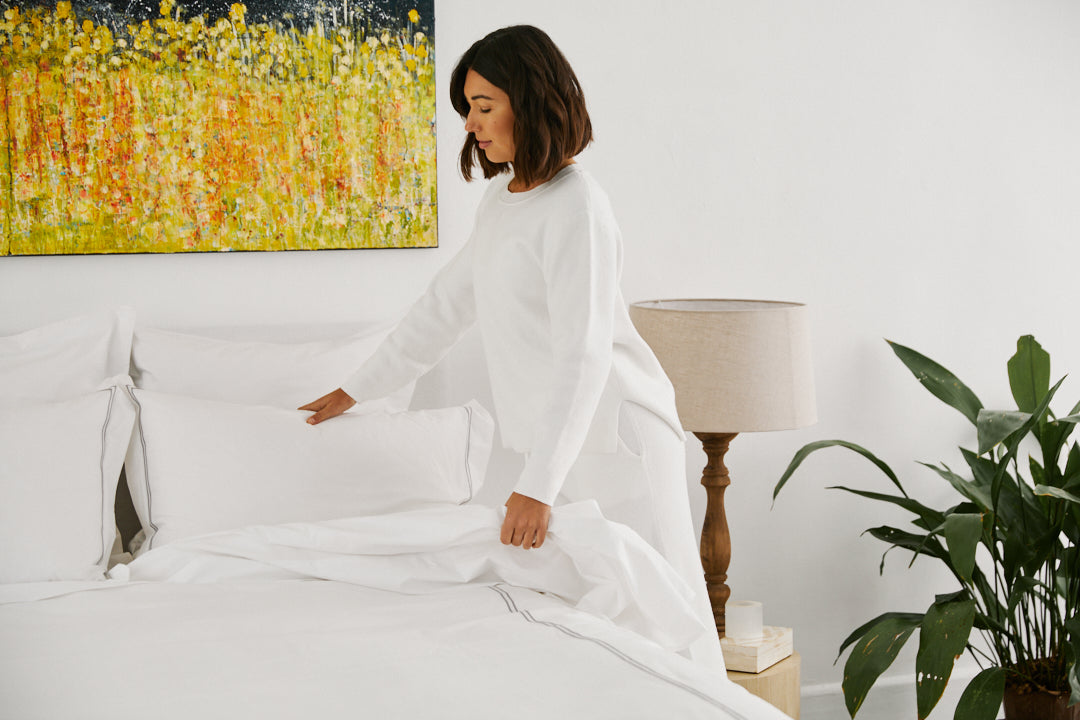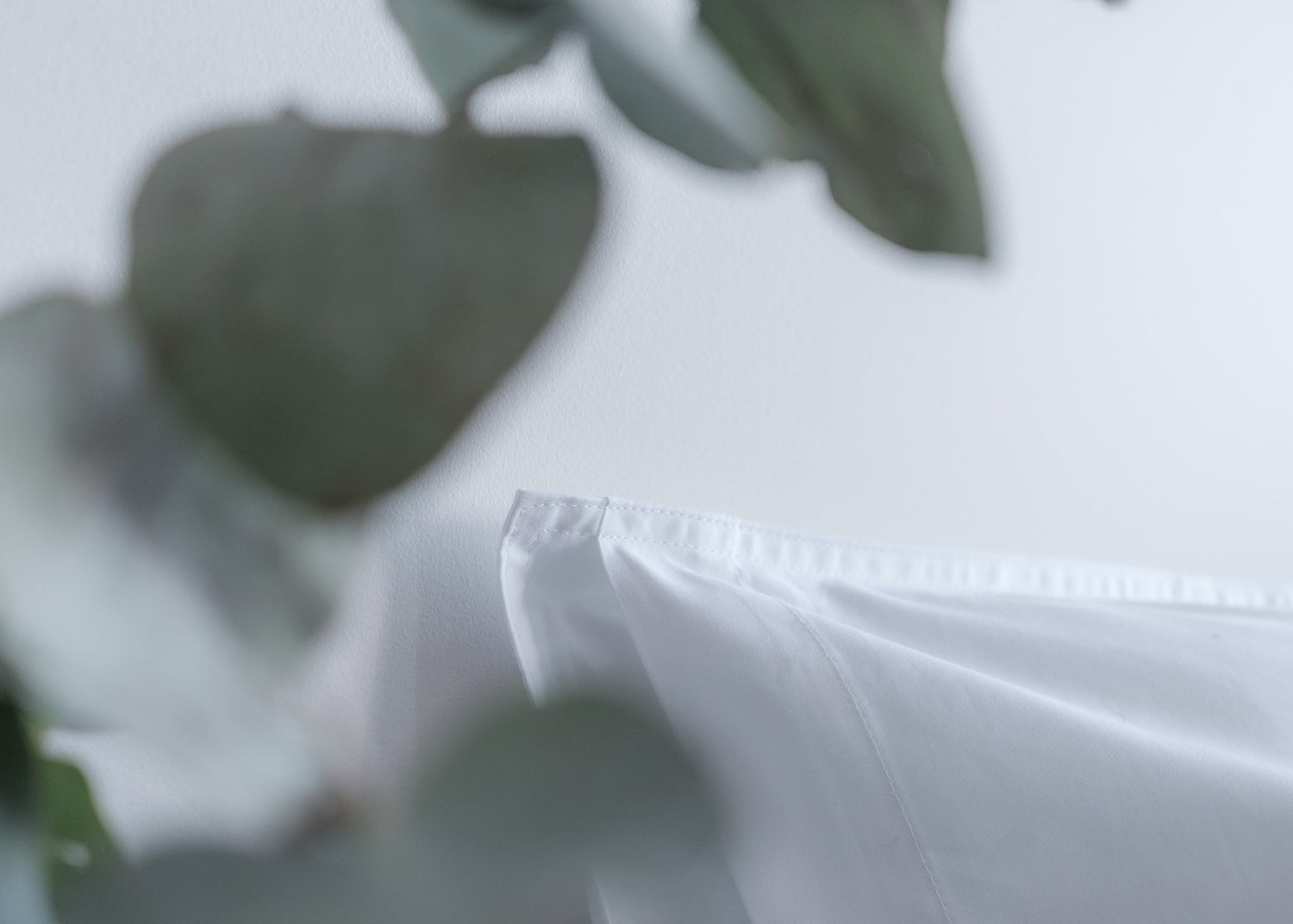
What are all the things to consider when buying bedding? Your comprehensive guide:
Share
Let’s face it, buying bedding should be simple. After all, it’s just sheets and blankets, right? Wrong! Choosing the perfect bedding is like navigating an obstacle course of fabric types, thread counts, colours, and mysterious “weaves” you never even knew existed. And yet, getting it right is so important. Your bed is your sanctuary—your personal cloud to escape from the chaos of the world.
To save you from a bedding-buying meltdown, we’ve put together this fun, light-hearted guide to all the things you need to consider before hitting "add to cart." You’ll be a bedding expert by the end of it—and your bed will thank you.
1. Material: Are You Team Cotton, Linen, or Something Else Entirely?
First things first: the material. This is where things get tricky, because there are so many options. Cotton, linen, bamboo, silk, polyester… the list goes on. Each material comes with its own perks (and occasional drawbacks), so let’s break it down:
- Cotton: The all-rounder. Breathable, soft, durable, and easy to care for. It’s like the pizza of fabrics—everyone loves it, and you really can’t go wrong.
- Linen: The fancy cousin of cotton. It’s airy, cool, and gets softer over time. Linen’s like the friend who looks effortlessly cool at all times—even in the heat of summer.
- Bamboo: Eco-friendly, moisture-wicking, and silky smooth. It’s like the yoga instructor of bedding: chilled out, natural, and good for the planet.
- Silk: Luxurious and smooth, but a bit high-maintenance. It’s like that designer outfit that makes you feel amazing but needs dry cleaning every five minutes.
- Polyester: Durable and budget-friendly, but let’s just say, it’s not winning any beauty contests. It can feel a bit plasticky and doesn’t breathe well. It’s kind of like the fast food of bedding—cheap, quick, but not always satisfying in the long run.
Pro Tip: If you’re looking for comfort, breathability, and low maintenance, cotton and linen are your best bets. Organic cotton, like the dreamy sheets we sell at EcoLinen (wink), is also a great eco-friendly option.
2. Thread Count: More Isn’t Always Better
Ah, the infamous thread count debate. You’ve probably heard that higher thread counts mean better sheets, but that’s only sort of true. Thread count refers to the number of threads woven into one square inch of fabric, and while a higher count can mean softer sheets, it’s not the be-all and end-all.
Here’s the deal: anything between 200 and 400 is usually perfect. Go much higher than that, and you might end up with sheets that are heavy and less breathable (aka sweaty).
If someone’s trying to sell you sheets with a thread count of 1000+, be suspicious. They might be trying to blind you with numbers instead of quality. Remember, it’s about the fabric too—high-quality cotton with a lower thread count will still feel amazing, while poor-quality fabric with a high thread count will feel, well, meh.
3. Size Matters (Don’t Be That Person Who Buys the Wrong Size)
We’ve all been there—excitedly tearing open new sheets, only to realise they don’t actually fit the bed. Not exactly the fairy-tale ending you were hoping for. So, before you click "buy," make sure you know your bed size. Here’s a quick refresher on bed sizes in Australia:
- Single: For one lucky sleeper (or a child).
- Double: A step up, but maybe still a squeeze for two adults.
- Queen: The go-to for couples who want a little room to stretch out.
- King: For couples who really like their space (or have a pet who insists on sharing the bed).
- Super King: Because why not sleep like royalty?
Don’t forget to check the depth of your mattress too! If you have a pillow-top or extra-thick mattress, make sure the fitted sheet has deep pockets, or you’ll be fighting with it all night. And trust me—nobody wins that battle.
4. Allergy Concerns: Don’t Let Dust Mites Crash Your Sleepover
If you’re allergic to dust mites (and let’s face it, who isn’t a bit squeamish about those tiny party crashers?), you’ll want to choose hypoallergenic bedding. Natural fibres like cotton and linen are great at keeping allergens at bay because they breathe better and don’t trap dust as much as synthetic materials.
Also, look for bedding that’s easy to wash at high temperatures, as that helps keep allergens in check. Nobody wants a runny nose ruining their beauty sleep!
5. Sustainability: Sleep Well, Save the Planet
It’s 2024, and being eco-friendly is the way to go. When buying bedding, think about the environmental impact. Organic cotton, like the bedding we offer at EcoLinen (hint hint), is grown without harmful pesticides and chemicals, making it a much greener option for both you and the planet. Plus, organic cotton is softer, more durable, and just feels better knowing it hasn’t harmed the environment.
Also, pay attention to packaging! Many bedding companies (like us!) are plastic-free, which means you won’t be left with a mountain of plastic waste when your sheets arrive. Sustainable bedding is a win-win—great for you and great for the Earth.
6. The Budget: What’s the Price of a Good Night’s Sleep?
Finally, let’s talk money. Bedding can range from budget-friendly to “I just spent my rent money on sheets.” While it’s tempting to go cheap, remember that bedding is an investment. You’ll spend about a third of your life in bed (no pressure!), so it’s worth spending a bit more for quality sheets that will last and give you a better night’s sleep.
Pro Tip: Go for the best quality you can afford, especially when it comes to natural fibres like organic cotton or linen. Cheap bedding might look good at first, but it won’t feel as nice or last as long. In the end, you’ll be back to shopping for new sheets sooner than you’d like.
The Bottom Line: Bedding Decisions Are Important, But They Can Be Fun!
There you have it—everything you need to consider before buying your next set of bed sheets to help you survive the process. Remember: choosing the right bedding isn’t just about the look or the price; it’s about creating a cosy, comfortable space that feels like you.
So go ahead—take the plunge, pick those perfect sheets

